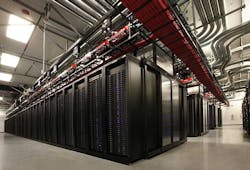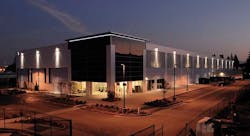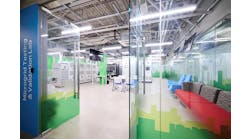SANTA CLARA, Calif. – A tour of the 18-acre campus of Vantage Data Centers campus offers insights into the recent evolution of the data center industry. That’s especially true for the V2 building, the largest of the three data centers on the property.
In one area of V2, high-density hyperscale workloads are running atop redundant electric infrastructure. Within the same building is a lab environment featuring a non-redundant (N) power configuration.
The ability to support this diverse mix of workloads made 2015 a banner leasing year for Vantage, which is now building more data center space in Santa Clara and looking for opportunities to expand into new geographies.
“Last year was a record year for us in customer growth and leasing,” said Vantage CEO Sureel Choksi, who said the company has been able to match its infrastructure to the needs of increasingly discerning data center customers. “We went from a company that had great engineering to one that puts the customer first.”
A Resurgence in Santa Clara
This is a story about resiliency. On one level, that means data center resiliency – the process of engineering a facility to continue operating when there is an equipment failure. Vantage is a leading beneficiary of the growing interest in variable resiliency, featuring data halls with less elaborate backup power infrastructure than traditional data centers. The company has won multiple deals for lab-style environments, whose high-density compute loads aren’t usually mission critical.
But it’s also about resiliency in the face of challenges. Both Vantage and the broader Silicon Valley market have successfully navigated tough conditions, surmounting customer churn and fluctuations in supply.[clickToTweet tweet=”Sureel Choksi: We went from a company that had great engineering to one that puts the customer first.” quote=”Sureel Choksi: We went from a company that had great engineering to one that puts the customer first.”]
Vantage Data Centers was founded in 2010 with backing from private equity firm Silver Lake Partners. The company acquired and redeveloped an Intel data center campus in Santa Clara, which has become the data center capital of Silicon Valley due to its affordable power. Despite being the new player in town, Vantage quickly signed leases for 15 megawatts of space.
In 2012, leasing activity in Santa Clara moderated. As several providers worked to lease newly-built space, Facebook began migrating out of its large footprint of leased facilities in Silicon Valley, shifting capacity to its new data center in Oregon.
“The market here went through a tough period of time,” said Choksi. “We’re now in a more rational phase.”
The V2 facility at the Vantage Data Centers campus in Santa Clara, Calif. (Photo: Vantage Data Centers)
Last year Santa Clara saw its most active leasing since 2011, according to an analysis by North American Data Centers, which tracks the wholesale data center market. In its annual market review, the real estate firm reported eight leases of 2 megawatts or more in the Santa Clara market during 2015, including four big leases for Vantage.
That hot demand has continued in the first quarter of 2016, with CoreSite signing a tenant for an entire phase of its new building in Santa Clara, while DuPont Fabros leasing a whopping 16 megawatts to a single customer.
An Opportunity in Labs
Choksi joined Vantage in 2013, coming from Silver Lake to take over as CEO. He has focused relentlessly on customer service, leading Vantage to tailor its business to support smaller customer requirements, greater flexibility in its power design, and a tighter relationship with customers. That includes access to Vantage’s in-house DCIM software and APIs that allow tenants to program specific views of their equipment and its performance.
“Customer service is the thing we care most about, and it’s been the biggest contributor to our success,” said Choksi.
Vantage saw an opportunity in the research labs operated by many Silicon Valley companies. These facilities are essential for testing software and hardware, and often live within office buildings.
“One thing we’ve seen here is a real push for data centers on headquarters campuses to be outsourced,” said Choksi. “One of the drivers is continued hiring and the need for office space, which is displacing these data centers and labs. We’ve been a beneficiary of that.”
In early 2015 Vantage leased 3 megawatts of space for a lab environment, followed by a multi-megawatt deal with Symantec for a hybrid configuration, split between lab space and traditional 2N mission-critical capacity.
Room for Customer Growth
Some of that lab space was deployed at V2, which has reaped the benefits of the turnaround in the Santa Clara market. When it was completed in 2012, V2 was hailed as “an entirely new data center vision” integrating concepts from the Open Compute Project, including a “penthouse” cooling system that uses the entire upper floor of the building as a plenum to process outside air for cooling servers.
Cooling infrastructure on the roof of the Vantage Data Centers V2 facility in Santa Clara. (Photo: Vantage Data Centers)
It was also built with a flexible approach to power infrastructure, allowing data halls to be configured for a range of density and redundancy.
V2 was developed in collaboration with a tenant that pre-leased the entire building, but was then unable to use all the space. By last fall, Vantage was offering 12 megawatts of space for lease at V2. But the company quickly experienced leasing success, and just three months later Vantage was able to move ahead with construction on a 6 megawatt expansion of its campus.
Having additional power and space available in Santa Clara is a priority for Vantage.
“What was most satisfying is that half our business (in 2015) was expansion by existing customers,” said Choksi. “It’s hard to overstate how important that is. We can accommodate our customers’ planned growth and their unforeseen capacity needs. The customers aren’t going to get landlocked, and that’s a big deal. We’re very committed to this market and will continue to expand.”
The new building will boost the capacity on the Vantage campus to 27 megawatts. The expansion, known as V4, will be attached to the existing V1 facility, which has been expanded to add space for additional mechanical and electrical infrastructure, as well as office space. The central plant on the campus is also being expanded to add chillers and cooling towers.
Vantage is building two 3-megawatt data halls within V4, according to Chief Operating Officer Chris Yetman, who noted that each building has a weather station that monitors temperature and humidity and adjusts the HVAC systems to adapt to changing conditions, ramping the physical plant as needed.
Customers Are Changing, Too
As it builds its infrastructure, Vantage is paying close attention to feedback from customers and prospects.
“As the industry has grown, customers have become more savvy,” said Choksi. “They come in knowing what they want, and are clear about what they want to pay. We’ve got a variety of things we can do. We offer all of those options, and work with our customers to configure what they need.”
Overhead power bus infrastructure within Vantage Data Centers’ Santa Clara campus. (Photo: Vantage Data Centers)
There are challenges in offering variable levels of resiliency on the same campus, particularly when it comes to planning and return on investment. That’s particularly true for a wholesale provider like Vantage that builds large footprints, often without a tenant lease in hand.
“Our job in capacity planning is a lot harder than when you have one product,” said Choksi. “We were a little early on the (flexible design) trend, and can be a little more nimble in meeting these requirements.
“When you accommodate different designs, you don’t want to build the wrong product,” he added. “We think a lot about what we build, and spend a lot of time, being very deliberate.”
New Markets on the Horizon
Vantage’s primary goal has been leasing space and supporting customers in its existing markets. In addition to Santa Clara, Vantage has a data center in Quincy, Washington that is leased to a single enterprise tenant.
“Our expansion has been focused in Santa Clara,” said Choksi. “Quincy is an interesting market and typically more build-to-suit than spec wholesale. Every year there’s two or three build-to-suit opportunities in Quincy, but it’s unlikely we’ll build spec there.”
Vantage is now thinking about geographic expansion. In February the company secured $295 million in additional debt financing, bringing its bank facility to $570 million. Vantage initially sought to expand its borrowing capacity by $200 million, but increased the offering when it received strong interest from lenders.
“To close on this oversubscribed, upsized financing with the strong support from our lenders, especially in light of difficult capital markets conditions, is a reflection of Vantage’s strong financial performance and growth prospects,” said Dave Renner, the Chief Financial Officer of Vantage.
The financing “gives us a couple hundred million in dry powder,” said Choksi, who said Vantage is evaluating opportunities.
“We have been focused on a handful of potential markets, and have ongoing discussions,” he said. “We tend to be very diligent. The check sizes are large, and we put a lot of work into this part of the process.”








